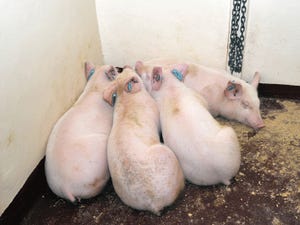4 steps to improve your swine herd's biosecurity
Best biosecurity plans are clearly defined and repeatable.
April 27, 2023

Are you having recurring health issues in your herd? Improving pig health and well-being may mean changing biosecurity protocols. Making a plan and getting everyone on board is crucial to success. Once everyone on the team understands why the changes are being made, they can buy in to ensure the changes are done correctly.
"Biosecurity is more than locks on doors, UV chambers and downtime tables – it's a cultural mindset," says Dr. Nicholas Lauterbach, technical services veterinarian for Pharmgate Animal Health. "Protocols help train new employees on processes and ensure they’re executed correctly to protect herd health."
Here are four tips to help make a biosecurity shift successful to protect and improve your herd's health.
1. Develop a realistic written plan
Making a written plan realistic is the most important aspect of creating or changing it.
"Changing protocols is difficult because we immediately want to make protocols more sophisticated and add more layers," explains Lauterbach. "The reality is the best biosecurity plans are clearly defined and repeatable."
If you are considering changing your protocols, ask yourself:
How easy will it be to train individuals on the new processes?
How are you going to verify that everyone is doing them correctly?
Adding or changing your protocol will only be effective if the people on the operation can do the new processes correctly.
"A big part of biosecurity protocol success is whether the written protocol is based on insight and experience of the true process," adds Dr. Jerome Geiger, health assurance veterinarian with Pig Improvement Company (PIC).
In his role, Geiger helps farms understand what's being implemented through system audits. He walks through each layer of the process at the different levels of management and labor, including upper management, production management and employees, to see where breakdowns occur.
For example, one person writes a protocol for washing a room or a truck to reduce contamination, but others are responsible for doing the washing. If those employees have never washed a room or truck before, the plan won't happen correctly. The plan must be written realistically and should include training.
2. Educate your team
Biosecurity processes add time to almost everything we do on the farm. Asking people to shower and change clothes before entering farms adds complexity and makes them less efficient, even before addressing in-barn biosecurity practices.
"These steps can be a strain on labor. But if you explain why they are important and how they can help to keep your herd free of disease, they will be more receptive," says Lauterbach.
Not knowing expectations is the biggest area Geiger sees people struggle, which can lead to inconsistency in execution. Lack of understanding or time pressures can break down communication. It's vital that everyone understands the protocols and buys in.
"You need people who are accountable and say, 'This is my job and I’m going to do it right from beginning to end,'" says Geiger.
3. Execute protocols
What's written on paper isn't always what’s executed day-to-day.
"On one farm I audited, the written protocols said every truck leaving the system should be disinfected," says Geiger. "But as I worked through each layer of the operation, we uncovered the wash system wasn't taking up disinfectant and no one knew it. So, what was happening didn't match the written protocol."
Once you've identified shortcomings like this, you can work to create a solution that works for everyone across the company.
Education and protocol execution go hand in hand, Lauterbach emphasizes. He suggests asking yourself: Is my team doing this the way I expect them to? You can have the most detailed and robust biosecurity protocols in the industry, but if employees cannot execute what you are asking them to do, they will not be as effective as you hope.
4. Document activities
Documentation is the last component of a successful health protocol. What evidence is there that you do X, Y or Z daily? Documentation is helpful when determining where the protocol breakdown is happening.
"Documentation doesn’t have to be specific to the protocols," says Geiger. "It might simply be reviewing a log of materials delivered to the facility and confirming the number of vaccine doses delivered matches the number of pigs vaccinated."
Biosecurity protocols need constant evaluation.
"We are always learning about processes and disease dynamics to help us make better decisions related to biosecurity," Lauterbach says.
Consider the preparation, execution and maintenance of biosecurity protocols before deciding if changing them is right for your operation.
You May Also Like



